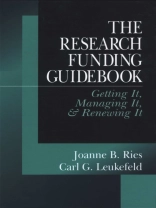Although the landscape of research funding is continually changing, over the past several years one feature has remained consistent: people who are young in their careers are expected to take on not only the responsibility of applying for external funding, but are also required to get it, manage it, and renew it in order to keep their research programs, projects, and careers viable. The Research Funding Guidebook begins at the point many grant seekers can identify withùrejection. Part I emphasizes how to resubmit unfunded applications to make them more competitive. The material contained in this section is invaluable, especially since funding sources are now limiting the number of times the same application can be resubmitted. Part II goes on to highlight the practical issues of a project after funding has been obtained. Here, the authors provide a map of the people and places that must become part of a researcherÆs daily and weekly routine. The guidance provided in this part of the book includes a checklist that can be used to aid the newly funded investigatorÆs progress. Time management, an essential but often overlooked feature of research funding, is also dealt with in this section. The subjects of other sections of this volume include the ‘small business’ aspects of maintaining funding for a project, and the process of targeting continued funding by determining the next fundable step of a project. This is a hands-on guide that will never be far from the reach of those using it. Topics like what to include in a project proposal, tips for competitive writing, and how to select funding sources are easily accessed. In addition, helpful checklists and samples are provided along the way. These practical features and the comprehensive, up-to-date information presented make The Research Funding Guidebook an indispensable reference for new and experienced investigators alike. Anyone interested in research funding in any academic discipline will find this book useful.
Содержание
Introduction
Getting It, Managing It, and Renewing It
PART ONE: RESUBMITTING A NOT FUNDED APPLICATION: ISSUES AND DECISIONS
Not-Funded? Identify the Reasons
Contending with Reviewers′ Comments
Modifying the Application
PART TWO: FUNDED! PRACTICAL ISSUES
Taking Advantage of the Award′s Rights and Responsibilities
Build Effective Organizational Relationships
PART THREE: FUNDED! WELCOME TO THE SMALL BUSINESS WORLD
Designing an Organization for the Project
Establishing Financial Procedures
Selecting Project Personnel
Communicating With Organizations and With the Scientific Community
PART FOUR: CONTINUING A PROJECT BY SUBMITTING A COMPETITIVE APPLICATION
Strategies to Identify a Continuation Project
Selecting a Funding Mechanism for a Continuation Project
PART FIVE: APPLICATION PREPARATION
What to Include in a Project Application
Writing to Be Competitive
Seeing It Through the Reviewers′ Eyes
PART SIX: OTHER CONSIDERATIONS
Related Research Issues
Thinking as the Heart of Science
Об авторе
Dr. Leukefeld is Professor of Behavioral Science, Psychiatry, Oral Health Science, Social Work and Public Health; and Chair of the Department of Behavioral Science, with a graduate appointment in Sociology. He came to the University of Kentucky in 1990 to establish the Center on Drug and Alcohol Research from the National Institute on Drug Abuse where he filled administrative and research positions. Dr. Leukefeld has published over 200 articles, chapters, books and monographs. He is a consulting editor for 6 journals. His research interests include treatment interventions, outcomes, HIV prevention, criminal justice sanctions, health services, and rural populations.












